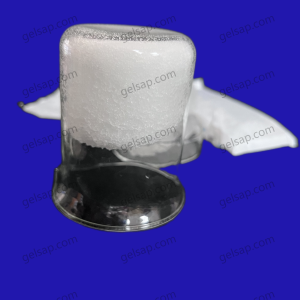The Inventor of Sodium Polyacrylate
Sodium polyacrylate, a superabsorbent polymer, was developed in the late 1960s by the U.S. Department of Agriculture (USDA). The invention is often attributed to Dr. Gene A. Hale and his team of researchers, who were exploring materials to improve water retention in soils, particularly for agricultural applications.
Why Does Sodium Polyacrylate Absorb Water?

폴리 아크릴 레이트 나트륨 absorbs water due to its unique chemical structure. It is composed of long chains of acrylate monomers, each containing a carboxyl group. These carboxyl groups are ionized (negatively charged) and attract water molecules through hydrogen bonding and electrostatic forces. When in contact with water, the polymer chains uncoil and expand, trapping large amounts of water within their structure. This ability to absorb and retain water is due to the polymer’s hydrophilic (water-attracting) nature.
Why Is Sodium Polyacrylate Absorbent?
The absorbency of sodium polyacrylate is primarily due to its cross-linked polymer structure. The cross-linking creates a network of spaces that can hold water molecules. Additionally, the presence of sodium ions (Na+) in the polymer enhances its water absorption capacity. When water is added, these ions dissociate, increasing the osmotic pressure within the polymer and causing it to swell and retain a significant amount of water relative to its weight.
Why Is Sodium Polyacrylate Used in Diapers?
Sodium polyacrylate is widely used in diapers due to its exceptional absorbent properties. It can absorb up to 300 times its weight in water, making it ideal for keeping the skin dry and preventing leaks. The polymer is incorporated into the core of the diaper, where it rapidly absorbs and traps urine, converting it into a gel-like substance. This not only enhances the comfort and dryness for the wearer but also reduces the risk of diaper rash and other skin irritations.
Can Sodium Polyacrylate Be Recycled?
Recycling sodium polyacrylate is challenging due to its complex chemical structure and the contamination it often faces after use. While the polymer itself is not biodegradable, there are ongoing research efforts to develop recycling and disposal methods that minimize environmental impact. Some potential recycling methods include:
- Physical Recycling: This involves mechanically breaking down used diapers to separate the sodium polyacrylate for reuse. However, this process can be labor-intensive and costly.
- Chemical Recycling: Chemical processes can break down sodium polyacrylate into its monomers, which can then be reused to create new polymers. This method is still under development and is not widely implemented.
- Biodegradation: Researchers are exploring the use of specific bacteria and enzymes that can degrade sodium polyacrylate. While promising, this approach is still in its experimental stages.
In conclusion, sodium polyacrylate is a remarkable material with extensive applications, particularly in the hygiene industry. Its invention has significantly improved the quality of life by providing efficient solutions for water absorption and retention. Although recycling remains a challenge, ongoing research and technological advancements hold promise for more sustainable management of this superabsorbent polymer in the future.

